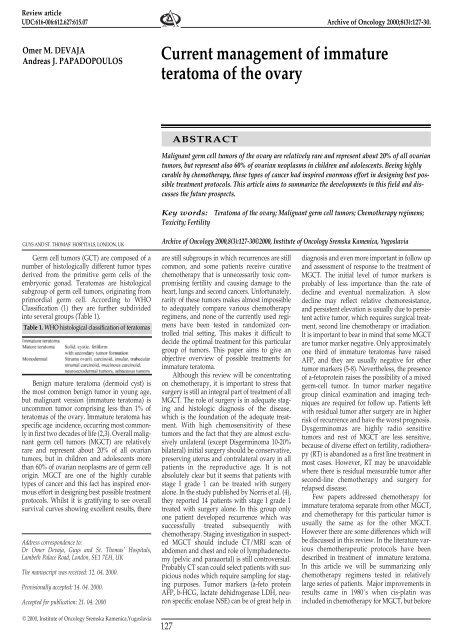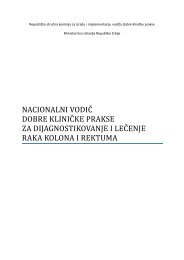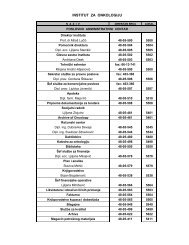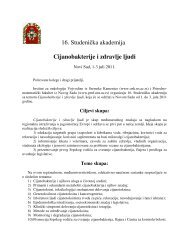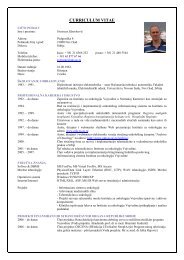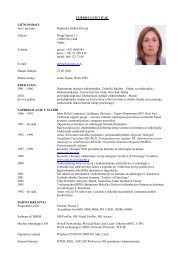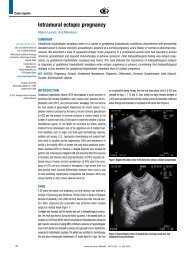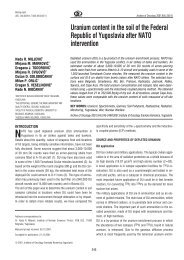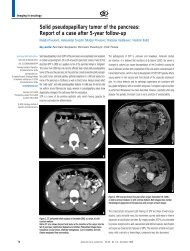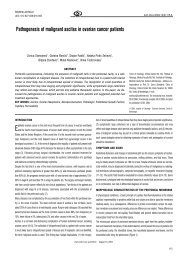Current management of immature teratoma of the ovary
Current management of immature teratoma of the ovary
Current management of immature teratoma of the ovary
Create successful ePaper yourself
Turn your PDF publications into a flip-book with our unique Google optimized e-Paper software.
Review article<br />
UDC:616-006:612.627:615.07<br />
Archive <strong>of</strong> Oncology 2000;8(3):127-30.<br />
Omer M. DEVAJA<br />
Andreas J. PAPADOPOULOS<br />
<strong>Current</strong> <strong>management</strong> <strong>of</strong> <strong>immature</strong><br />
<strong>teratoma</strong> <strong>of</strong> <strong>the</strong> <strong>ovary</strong><br />
ABSTRACT<br />
Malignant germ cell tumors <strong>of</strong> <strong>the</strong> <strong>ovary</strong> are relatively rare and represent about 20% <strong>of</strong> all ovarian<br />
tumors, but represent also 60% <strong>of</strong> ovarian neoplasms in children and adolescents. Beeing highly<br />
curable by chemo<strong>the</strong>rapy, <strong>the</strong>se types <strong>of</strong> cancer had inspired enormous effort in designing best possible<br />
treatment protocols. This article aims to summarize <strong>the</strong> developments in this field and discusses<br />
<strong>the</strong> future prospects.<br />
Key words: Teratoma <strong>of</strong> <strong>the</strong> <strong>ovary</strong>; Malignant germ cell tumors; Chemo<strong>the</strong>rapy regimens;<br />
Toxicity; Fertility<br />
GUYS AND ST. THOMAS’ HOSPITALS, LONDON, UK<br />
Archive <strong>of</strong> Oncology 2000,8(3):127-30Ç2000, Institute <strong>of</strong> Oncology Sremska Kamenica, Yugoslavia<br />
Germ cell tumors (GCT) are composed <strong>of</strong> a<br />
number <strong>of</strong> histologically different tumor types<br />
derived from <strong>the</strong> primitive germ cells <strong>of</strong> <strong>the</strong><br />
embryonic gonad. Teratomas are histological<br />
subgroup <strong>of</strong> germ cell tumors, originating from<br />
primordial germ cell. According to WHO<br />
Classification (1) <strong>the</strong>y are fur<strong>the</strong>r subdivided<br />
into several groups (Table 1).<br />
Table 1. WHO histological classification <strong>of</strong> <strong>teratoma</strong>s<br />
Benign mature <strong>teratoma</strong> (dermoid cyst) is<br />
<strong>the</strong> most common benign tumor in young age,<br />
but malignant version (<strong>immature</strong> <strong>teratoma</strong>) is<br />
uncommon tumor comprising less than 1% <strong>of</strong><br />
<strong>teratoma</strong>s <strong>of</strong> <strong>the</strong> <strong>ovary</strong>. Immature <strong>teratoma</strong> has<br />
specific age incidence, occurring most commonly<br />
in first two decades <strong>of</strong> life (2,3). Overall malignant<br />
germ cell tumors (MGCT) are relatively<br />
rare and represent about 20% <strong>of</strong> all ovarian<br />
tumors, but in children and adolescents more<br />
than 60% <strong>of</strong> ovarian neoplasms are <strong>of</strong> germ cell<br />
origin. MGCT are one <strong>of</strong> <strong>the</strong> highly curable<br />
types <strong>of</strong> cancer and this fact has inspired enormous<br />
effort in designing best possible treatment<br />
protocols. Whilst it is gratifying to see overall<br />
survival curves showing excellent results, <strong>the</strong>re<br />
Address correspondence to:<br />
Dr Omer Devaja, Guys and St. Thomas’ Hospitals,<br />
Lambeth Palace Road, London, SE1 7EH, UK<br />
The manuscript was received: 12. 04. 2000.<br />
Provisionally accepted: 14. 04. 2000.<br />
Accepted for publication: 21. 04. 2000<br />
Ç 2000, Institute <strong>of</strong> Oncology Sremska Kamenica,Yugoslavia<br />
are still subgroups in which recurrences are still<br />
common, and some patients receive curative<br />
chemo<strong>the</strong>rapy that is unnecessarily toxic compromising<br />
fertility and causing damage to <strong>the</strong><br />
heart, lungs and second cancers. Unfortunately,<br />
rarity <strong>of</strong> <strong>the</strong>se tumors makes almost impossible<br />
to adequately compare various chemo<strong>the</strong>rapy<br />
regimens, and none <strong>of</strong> <strong>the</strong> currently used regimens<br />
have been tested in randomized controlled<br />
trial setting. This makes it difficult to<br />
decide <strong>the</strong> optimal treatment for this particular<br />
group <strong>of</strong> tumors. This paper aims to give an<br />
objective overview <strong>of</strong> possible treatments for<br />
<strong>immature</strong> <strong>teratoma</strong>.<br />
Although this review will be concentrating<br />
on chemo<strong>the</strong>rapy, it is important to stress that<br />
surgery is still an integral part <strong>of</strong> treatment <strong>of</strong> all<br />
MGCT. The role <strong>of</strong> surgery is in adequate staging<br />
and histologic diagnosis <strong>of</strong> <strong>the</strong> disease,<br />
which is <strong>the</strong> foundation <strong>of</strong> <strong>the</strong> adequate treatment.<br />
With high chemosensitivity <strong>of</strong> <strong>the</strong>se<br />
tumors and <strong>the</strong> fact that <strong>the</strong>y are almost exclusively<br />
unilateral (except Disgerminoma 10-20%<br />
bilateral) initial surgery should be conservative,<br />
preserving uterus and contralateral <strong>ovary</strong> in all<br />
patients in <strong>the</strong> reproductive age. It is not<br />
absolutely clear but it seems that patients with<br />
stage I grade 1 can be treated with surgery<br />
alone. In <strong>the</strong> study published by Norris et al. (4),<br />
<strong>the</strong>y reported 14 patients with stage I grade 1<br />
treated with surgery alone. In this group only<br />
one patient developed recurrence which was<br />
successfully treated subsequently with<br />
chemo<strong>the</strong>rapy. Staging investigation in suspected<br />
MGCT should include CT/MRI scan <strong>of</strong><br />
abdomen and chest and role <strong>of</strong> lymphadenectomy<br />
(pelvic and paraaortal) is still controversial.<br />
Probably CT scan could select patients with suspicious<br />
nodes which require sampling for staging<br />
purposes. Tumor markers (a-feto protein<br />
AFP, b-HCG, lactate dehidrogenase LDH, neuron<br />
specific enolase NSE) can be <strong>of</strong> great help in<br />
127<br />
diagnosis and even more important in follow up<br />
and assessment <strong>of</strong> response to <strong>the</strong> treatment <strong>of</strong><br />
MGCT. The initial level <strong>of</strong> tumor markers is<br />
probably <strong>of</strong> less importance than <strong>the</strong> rate <strong>of</strong><br />
decline and eventual normalization. A slow<br />
decline may reflect relative chemoresistance,<br />
and persistent elevation is usually due to persistent<br />
active tumor, which requires surgical treatment,<br />
second line chemo<strong>the</strong>rapy or irradiation.<br />
It is important to bear in mind that some MGCT<br />
are tumor marker negative. Only approximately<br />
one third <strong>of</strong> <strong>immature</strong> <strong>teratoma</strong>s have raised<br />
AFP, and <strong>the</strong>y are usually negative for o<strong>the</strong>r<br />
tumor markers (5-8). Never<strong>the</strong>less, <strong>the</strong> presence<br />
<strong>of</strong> a-fetoprotein raises <strong>the</strong> possibility <strong>of</strong> a mixed<br />
germ-cell tumor. In tumor marker negative<br />
group clinical examination and imaging techniques<br />
are required for follow up. Patients left<br />
with residual tumor after surgery are in higher<br />
risk <strong>of</strong> recurrence and have <strong>the</strong> worst prognosis.<br />
Dysgerminomas are highly radio sensitive<br />
tumors and rest <strong>of</strong> MGCT are less sensitive,<br />
because <strong>of</strong> diverse effect on fertility, radio<strong>the</strong>rapy<br />
(RT) is abandoned as a first line treatment in<br />
most cases. However, RT may be unavoidable<br />
where <strong>the</strong>re is residual measurable tumor after<br />
second-line chemo<strong>the</strong>rapy and surgery for<br />
relapsed disease.<br />
Few papers addressed chemo<strong>the</strong>rapy for<br />
<strong>immature</strong> <strong>teratoma</strong> separate from o<strong>the</strong>r MGCT,<br />
and chemo<strong>the</strong>rapy for this particular tumor is<br />
usually <strong>the</strong> same as for <strong>the</strong> o<strong>the</strong>r MGCT.<br />
However <strong>the</strong>re are some differences which will<br />
be discussed in this review. In <strong>the</strong> literature various<br />
chemo<strong>the</strong>rapeutic protocols have been<br />
described in treatment <strong>of</strong> <strong>immature</strong> <strong>teratoma</strong>.<br />
In this article we will be summarizing only<br />
chemo<strong>the</strong>rapy regimens tested in relatively<br />
large series <strong>of</strong> patients. Major improvements in<br />
results came in 1980´s when cis-platin was<br />
included in chemo<strong>the</strong>rapy for MGCT, but before
Devaja M. O.<br />
cis-platin most commonly used drugs were<br />
Vincristine, Actinomicin-D and<br />
Cyclophosphamide (VAC regimen). Although<br />
<strong>the</strong>re were some differences in VAC regimen in<br />
published data, it seems that high dose VAC<br />
regimen (Table 2) (9) had good results in <strong>the</strong><br />
treatment <strong>of</strong> Stage I MGCT (5,10-12).<br />
Unfortunately, this regimen was not as efficient<br />
in higher stages and recurrences were common<br />
in this group <strong>of</strong> patients (13).<br />
Table 2. VAC regimen<br />
Schwartz et al. (9) recommended 6 courses<br />
<strong>of</strong> VACchemo<strong>the</strong>rapy followed by second-look<br />
operation in tumor marker negative group and<br />
<strong>the</strong> tumor marker positive group should be<br />
treated until <strong>the</strong> tumor markers were back to<br />
normal level. In <strong>the</strong>ir published results <strong>the</strong>y had<br />
6 <strong>immature</strong> <strong>teratoma</strong>s (5 stage I and 1 stage III)<br />
and after <strong>the</strong> treatment with VAC all patients<br />
had no evidence <strong>of</strong> disease 34-82 months later,<br />
and all patients received more than 6 courses <strong>of</strong><br />
chemo<strong>the</strong>rapy (between 8 and 18 courses). The<br />
largest case series on <strong>immature</strong> <strong>teratoma</strong> only<br />
using VAC was published by Gershenson (5).<br />
They reported 41 patients out <strong>of</strong> which 16 were<br />
treated with surgery alone ( 11 stage I and 5<br />
stage III). Fifteen <strong>of</strong> 16 patients treated with<br />
surgery alone developed recurrent disease and<br />
11 survived after subsequent chemo<strong>the</strong>rapy,<br />
only one patient was stage I grade 1 who also<br />
recurred after treatment with surgery alone.<br />
Twenty one patients received VAC protocol, 2<br />
had RT and 2 patients received chemo<strong>the</strong>rapy<br />
with Doxorubicin + Cyclophosphamide and<br />
Actinomycin-D,5-flurouracil<br />
Cyclophosphamide (AcFuCy protocol). Twenty<br />
nine <strong>of</strong> <strong>the</strong> 41 patients (71%) were long term survivors.<br />
Ten patients died <strong>of</strong> tumor and two died<br />
<strong>of</strong> leukemia. In <strong>the</strong>ir series patients received<br />
between 12-18 cycles <strong>of</strong> VAC regimen. The published<br />
data it suggest that patients with stage I<br />
grade 2 & 3 and higher stages run a high risk <strong>of</strong><br />
recurrence which justifies <strong>the</strong> use <strong>of</strong> adjuvant<br />
chemo<strong>the</strong>rapy in this group <strong>of</strong> patients.<br />
However, it is unclear which <strong>the</strong>rapy and how<br />
many cycles would give <strong>the</strong> best balance<br />
between efficacy and toxicity.<br />
As it was already mentioned, <strong>the</strong> major<br />
improvement in terms <strong>of</strong> response and survival<br />
was inclusion <strong>of</strong> cis-platin in regimens for<br />
MGCT. One <strong>of</strong> <strong>the</strong> first regimens with cisplatin<br />
was reported by Newlands et al. (14) using<br />
sequential chemo<strong>the</strong>rapy schedules in eighteen<br />
patients with <strong>immature</strong> <strong>teratoma</strong>s. In this series<br />
<strong>the</strong> majority <strong>of</strong> treated patients had advanced<br />
disease (Table 3).<br />
Ç 2000, Institute <strong>of</strong> Oncology Sremska Kamenica,Yugoslavia<br />
Table 3. Stage and survival <strong>of</strong> patients with<br />
Immature <strong>teratoma</strong><br />
Protocol A:<br />
day 1 - Vincristine 1mg/m 2 injestion<br />
folowed by Methotrexate 100 mg/m 2 and <strong>the</strong>n<br />
Methotrexate 200 mg/m 2 in 12h infusion<br />
day 2 - Bleomycin 15 mg/in 24h intravenous<br />
infusion; Folinic acid 24h after Methotrexate 15<br />
mg/12h x 4<br />
day 3 - Bleomycin 15 mg in 24h infusion<br />
day 4 - Cis-platin 120 mg/m 2 with prehydratation<br />
Protocol B:<br />
day 1 - 5 Etoposide 100 mg/m2 iv<br />
day 3,4,5 Actinomycin D 0.5 mg iv<br />
day 5 Cyclophosphamide 500 mg/m 2 iv<br />
Protocol C:<br />
Hydroxyuirea, Vinblastine and<br />
Chlorambucil later omitted because <strong>of</strong> resistance<br />
Protocol D:<br />
Identical to Protocol A with omission <strong>of</strong> Cisplatin<br />
128<br />
Patients received two courses <strong>of</strong> regimen A,<br />
followed by regimen B. If <strong>the</strong>re was no complete<br />
remission <strong>the</strong>y alternated between treatment A<br />
and B until complete clinical and biochemical<br />
remission was achieved. After <strong>the</strong> remission, <strong>the</strong><br />
treatment was continued alternating protocol B<br />
and D until remission had been maintained for<br />
approximately 12 weeks. Intervals between <strong>the</strong><br />
courses <strong>of</strong> chemo <strong>the</strong>rapy were adjusted to<br />
allow <strong>the</strong> recovery from myelosuppression and<br />
were normally between 9 and 14 days. This<br />
chemo<strong>the</strong>rapy schedule showed good results in<br />
advanced stages but it was technically demanding<br />
and toxicity was not reported in this paper.<br />
Schwartz treated one patient, with stage III<br />
<strong>immature</strong> <strong>teratoma</strong>, with new combination<br />
chemo<strong>the</strong>rapy Cis-platin, Vinblastine and<br />
Bleomycin (PVB), and although this regimen<br />
showed good efficacy, <strong>the</strong> treatment was associated<br />
with high toxicity (9). O<strong>the</strong>r reports confirm<br />
activity <strong>of</strong> this regimen in MGCT (15-18).<br />
Some authors added Methotrexate to this protocol<br />
but it seems with no great impact on efficacy.<br />
PVB protocol:<br />
days 1 - 5 Cisplatin 20 mg/m 2<br />
days 1&2 Vinblastine 0.15 mg/kg<br />
days 1, 8, 15 Bleomycin 30 mg<br />
repeat every 21 days<br />
Soon after, it was established that Etoposide<br />
is more effective than Vinblastine which resulted<br />
in <strong>the</strong> combination <strong>of</strong> Bleomycin, Etoposide,<br />
Cis-platin (BEP). This regimen was also associated<br />
with less toxicity and is given every 21<br />
days.<br />
BEP protocol:<br />
day 1 - 5 Cisplatin 20 mg/m 2<br />
day 1 - 5 Etoposide 100 mg/m 2<br />
day 1 Bleomycin 30 mg<br />
repeat weekly<br />
Nowadays BEP protocol is most widely<br />
used as first line treatment with very good<br />
results (13,19,20). It is difficult to asses recurrence<br />
rate especially for <strong>immature</strong> <strong>teratoma</strong>s<br />
because <strong>of</strong> small numbers and different stage<br />
distribution among <strong>the</strong> published series. Most <strong>of</strong><br />
<strong>the</strong> authors suggest that 3 courses <strong>of</strong> BEP regimen<br />
should be given for all stage I grade 2&3<br />
tumors to prevent recurrence. In higher stages<br />
number <strong>of</strong> courses required to achieve complete<br />
remission is more than 3 and total number<br />
depends on response and toxicity.<br />
Recently, Bower et al. (21) published <strong>the</strong>ir<br />
series <strong>of</strong> 77 women with MGCT (19 with <strong>immature</strong><br />
<strong>teratoma</strong>) treated in Charing Cross<br />
Hospital in London and majority <strong>of</strong> patients<br />
were in advanced stage disease (11 stage I, 15<br />
stage II, 20 stage III, 13 stage IV). Using protocol<br />
POMB/ACE (Table 4) <strong>the</strong>y achieved a 3-year<br />
survival <strong>of</strong> 80.7% for <strong>the</strong> whole population <strong>of</strong> 77<br />
patients and <strong>the</strong> survival figure was 87.0% when<br />
12 patients initially treated elsewhere were<br />
excluded from <strong>the</strong> analysis. This regimen had<br />
excellent efficacy with acceptable toxicity. There<br />
were no deaths related to <strong>the</strong> treatment<br />
although one patient died from acute myeloid<br />
leukemia 7 months after chemo<strong>the</strong>rapy receiving<br />
a total <strong>of</strong> 1300 mg/m 2 <strong>of</strong> Etoposide.<br />
POMB/ACE is administered every 14 days<br />
and alternates between POMB and ACE regiments<br />
after <strong>the</strong> first two cycles which are both<br />
POMBs.<br />
Treatment <strong>of</strong> MGCT is a fine balance <strong>of</strong> optimal<br />
result with minimal toxicity. The high dose<br />
VAC regimen would be adequate for many<br />
tumors, but late sequelae <strong>of</strong> <strong>the</strong>se agents (myelosuppresion,<br />
infertility, cardiac toxicity) are<br />
unacceptable when high cure rates can be<br />
achieved with platinum-based chemo<strong>the</strong>rapy.<br />
Undoubtely, <strong>the</strong>re are some late toxicities with<br />
platinum-based regimens, although, with limited<br />
total dose <strong>the</strong>se sequelae should not be<br />
severe (22,23). Decline in glomerular filtration<br />
rate and high tone hearing loss on audiometry is<br />
almost inevitable where <strong>the</strong> cumulative dose <strong>of</strong><br />
Cis-platin exceeds 3-400 mg/m 2 .
<strong>Current</strong> <strong>management</strong> <strong>of</strong> <strong>immature</strong> <strong>teratoma</strong> <strong>of</strong> <strong>the</strong> <strong>ovary</strong><br />
Table 4. POMB/ACE regimen<br />
Pulmonary toxicity is well recognized with<br />
<strong>the</strong> use <strong>of</strong> Bleomycin and toxicity is higher when<br />
weekly administration is used in <strong>the</strong> protocol.<br />
Adverse effect on fertility, persistent skin pigmentation<br />
and Raynaud’s phenomenon are also<br />
attributed to Bleomycin. Vinblastine is less well<br />
tolerated than Etoposide and not more effective,<br />
which makes BEP regimen more acceptable than<br />
PVB. Etoposide has been associated with induction<br />
<strong>of</strong> second malignancy, although a <strong>the</strong>oretical<br />
problem, <strong>the</strong>re is little evidence that second<br />
cancers occur due to three-weekly Etopside<br />
where cumulative dose is low (24-26). Studies<br />
looking at <strong>the</strong> value <strong>of</strong> replacing Cis-platin with<br />
Carboplatin in order to reduce <strong>the</strong> toxicity (27-<br />
30) indicate that Cis-platin is superior to<br />
Carboplatin, although, it has to be said that <strong>the</strong><br />
dose <strong>of</strong> Carboplatin was suboptimal in majority<br />
<strong>of</strong> <strong>the</strong> cases as <strong>the</strong> dose was not calculated using<br />
Calvert/Newel formula (dose mg = desired<br />
AUC x uncorrected GFR + 20). Fur<strong>the</strong>r studies<br />
are needed to answer this question. Ano<strong>the</strong>r<br />
interesting question is: can Bleomycin be omitted<br />
to reduce long-term toxicity? In <strong>the</strong> study<br />
from Memorial Sloan-Kettering Cancer Center<br />
(31) comparing five drug regimen<br />
Cyclophosphamide, Vinblastine, Dactinomycin,<br />
Bleomycin and Cis-platin (VAB-6) with two<br />
drug regimen <strong>of</strong> Cis-platin and Etoposide, <strong>the</strong>y<br />
concluded that <strong>the</strong>re was no difference in a 2-<br />
year survival in good-risk group between <strong>the</strong><br />
two regimens. Toxicity was substantially<br />
reduced in <strong>the</strong> group receiving <strong>the</strong> two drug<br />
regimen. In this study, <strong>the</strong>y were using logistic<br />
model to determine <strong>the</strong> probability <strong>of</strong> complete<br />
response in order to define good-risk group. In<br />
o<strong>the</strong>r study (32), comparing PB versus PVB <strong>the</strong><br />
CR rate was similar (89% versus 94%) but <strong>the</strong><br />
eventual death rate from progressive malignancy<br />
was 15% in PB group versus 5% in PVB. The<br />
overall survival difference was not significant,<br />
due to higher proportion <strong>of</strong> toxic deaths in three<br />
drug regimen. Subsequent study compared BEP<br />
with EP in patients with favourable prognosis <strong>of</strong><br />
disseminated MGCT (33). In this study, overall<br />
survival was better (95%) with BEP than (86%)<br />
with EP indicating a significant role <strong>of</strong><br />
Bleomycin. There is clearly a need for large multicentric<br />
study to clarify this issue.<br />
Not many reports addressed fertility rate in<br />
great detail which makes it difficult to compare<br />
different regimens in respect to <strong>the</strong>ir effect on<br />
fertility. However, many o<strong>the</strong>r factors not related<br />
to <strong>the</strong> treatment may influence final fertility<br />
rate. Fertility rate after conservative surgery and<br />
chemo<strong>the</strong>rapy is between 70%-83.3 % according<br />
to published data which certainly justifies conservative<br />
approach in <strong>the</strong> treatment <strong>of</strong> MGCT<br />
(34,35). There have been no fetal abnormalities<br />
observed so far related to <strong>the</strong> treatment.<br />
Majority <strong>of</strong> conservatively treated patients<br />
retained <strong>the</strong>ir ovarian endocrine function.<br />
It is still uncertain what <strong>the</strong> best salvage<br />
<strong>the</strong>rapy for recurrent disease is. Several active<br />
chemo<strong>the</strong>rapeutic agents can be used in <strong>the</strong><br />
event <strong>of</strong> relapse following <strong>the</strong> first line treatments,<br />
and <strong>the</strong> decision depends on previously<br />
used drugs. Ifosfamide (36), Doxorubicin,<br />
Actinomycin and Methotrexate (37) and o<strong>the</strong>r<br />
regimens (38) showed effectivenes as salvage<br />
<strong>the</strong>rapy in MGCT. Increase dose intensity with<br />
previously used drugs may produce responses<br />
(39). The role <strong>of</strong> very high dose combination<br />
chemo<strong>the</strong>rapy, requiring autologous bone marrow<br />
or stem cell rescue is still uncertain (40-42).<br />
Radio <strong>the</strong>rapy could be given in refractory<br />
tumors.<br />
There are still several important questions<br />
waiting to be answered: <strong>the</strong> most effective <strong>the</strong><br />
least toxic first line chemo<strong>the</strong>rapy needs to be<br />
defined; clear identification <strong>of</strong> low-risk and<br />
high-risk groups to enable administration <strong>of</strong><br />
most appropriate treatment; and <strong>the</strong> definition<br />
<strong>of</strong> <strong>the</strong> most active salvage <strong>the</strong>rapy. Answering<br />
<strong>the</strong>se questions would require large national or<br />
international collaborative randomized studies.<br />
REFERENCES<br />
1. Scully RE, Fox H, Russel P, Saksela E, Sasano N, Sobin<br />
LH. World Health Organisation and International Society <strong>of</strong><br />
Gynecological Pathologist classification <strong>of</strong> <strong>the</strong> tumors <strong>of</strong> <strong>the</strong><br />
<strong>ovary</strong>, fallopian tube and peritoneum. Heidelberg: Springer-<br />
Verlag, 1995 .<br />
2. Breen JL, Neubecker RD. Malignant <strong>teratoma</strong> <strong>of</strong> <strong>the</strong><br />
<strong>ovary</strong>. An analysis <strong>of</strong> 17 cases. Obstet Gynecol 1967;21:669.<br />
3. Malkasian GD Jr, Symmonds RE, Dockerty MB.<br />
Malignant ovarian <strong>teratoma</strong>s. Report <strong>of</strong> 31 cases. Obstet<br />
Gynecol 1965;25:810.<br />
4. Norris HJ, Zirkin HJ, Benson WI. Immature (malignant)<br />
<strong>teratoma</strong> <strong>of</strong> <strong>the</strong> <strong>ovary</strong>. Cancer 1976;37:2359.<br />
5. Gershenson DM, DelJunco G, Silva EG et al. Immature<br />
Teratoma <strong>of</strong> <strong>the</strong> Ovary. Obstet Gynecol 1986;68:624.<br />
6. Bahari CM, Lurie M, Schoenfeld A. Ovarian <strong>teratoma</strong><br />
with peritoneal gliomatosis and elevated serum alpha-fetoprotein.<br />
Am J Clin Pathol 1980;73:603.<br />
7. Esterhay PJ, Shapiro HM, Su<strong>the</strong>rland JC et al. Serum<br />
alpha-fetoprotein concentration and tumor growth disassociation<br />
in a patient with ovarian teratocarcinoma. Cancer<br />
1973;31:835.<br />
8. Taleman A, Hagi WG. Alpha-fetoprotein and germ cell<br />
tumors: A possible role <strong>of</strong> yolk sac tumor in production <strong>of</strong><br />
alpha-fetoprotein. Cancer 1974;34:1722.<br />
9. Schwartz PE. Combination Chemo<strong>the</strong>rapy in <strong>the</strong> <strong>management</strong><br />
<strong>of</strong> ovarian germ cell malignancies. Obstet Gynecol<br />
1984;64:564.<br />
10. Piura B, Dgani R, Zalel Y et al. Malignant germ cell<br />
tumors <strong>of</strong> <strong>the</strong> <strong>ovary</strong> : A study <strong>of</strong> 20 cases. J Surg Oncol<br />
1995;59:155.<br />
11. Gershenson DM, Copeland LJ, Kavanagh JJ et al.<br />
Treatment <strong>of</strong> malignant nondysgerminatous germ cell<br />
tumors <strong>of</strong> <strong>the</strong> <strong>ovary</strong> with Vincristine, Actinomycin-D and<br />
Cyclophosphamide. Cancer 1985;56:2756.<br />
12. Slayton RE Park RC, Silveberg SG. Vincristine,<br />
Dactinomycin and Cyclophosphamide in <strong>the</strong> treatment <strong>of</strong><br />
malignant germ cell tumors <strong>of</strong> <strong>the</strong> <strong>ovary</strong>. A Gynaecologic<br />
Oncology Group Study. Cancer 1985;56:243.<br />
13. Nair R, Pai SK, Saikia TK et al. Malignant germ cell<br />
tumors in childhood. J Surg Oncol 1994;56:186.<br />
14. Newlands ES, Begent RHJ, Bagshawe KD. Potential for<br />
cure in metastatic ovarian <strong>teratoma</strong>s and dysgerminomas.<br />
Br J Obst Gynaecol 1982;89:555.<br />
15. Lokey JL, Baker JJ, Price NA et al. Cis-platin, Vinblastine<br />
and Bleomycin for endodermal sinus tumour <strong>of</strong> <strong>the</strong> <strong>ovary</strong>.<br />
Ann Intern Med 1981;94:56.<br />
16. Julian CG, Barrett JM, Richardson et al. Bleomycin.,<br />
Vinblastine and Cis-platin in <strong>the</strong> treatment <strong>of</strong> advanced<br />
endodermal sinus tumor. Obstet Gynecol 1980;56:396.<br />
17. Williams S, Slayton R, Silveberg S et al. Response <strong>of</strong><br />
malignant ovarian germ cell tumors to Cis-platin,<br />
Vinblastine and Bleomycin (PVB). Proc Am Assoc Cancer<br />
Res Am Soc Clin Oncol 1981;22:463.<br />
18. Carlson RW, Sikic BI, Turbow MM et al. Combination<br />
Cis-platin Vinblastine and Bleomycin chemo<strong>the</strong>rapy (PVB)<br />
for malignant germ-cell tumors <strong>of</strong> <strong>the</strong> <strong>ovary</strong>. J Clin Oncol<br />
1983;1:645.<br />
19. Williams SD, Blessing JA, Liao SY et al. Adjuvant <strong>the</strong>rapy<br />
<strong>of</strong> ovarian germ cell tumors with Cis-platin Etoposide<br />
and Bleomycin: A trial <strong>of</strong> <strong>the</strong> Gynaecologic Oncology<br />
Group. J Clin Oncol 1994;12:701.<br />
20. Williams SD, Birch R, Einhorn LH et al. Disseminated<br />
germ cell tumors: Chemo<strong>the</strong>rapy with Cis-platin plus<br />
Bleomycin plus ei<strong>the</strong>r Vinblastine or Etoposide. N Engl J<br />
Med 1987;316:1435.<br />
21. Bower M, Fife K, Newlands ES et al. Chemo<strong>the</strong>rapy for<br />
ovarian germ cell tumours. Eur J Cancer 1996;32A:593.<br />
22. BoyerM, Raghavan D, Harris PJ et al. Lack <strong>of</strong> late toxicity<br />
in patients treated with cis-platin containing combination<br />
chemo<strong>the</strong>rapy for metastatic testicular cancer. J Clin Oncol<br />
1990;8:21.<br />
23. Bokemeyer C, Berger CC, Kuczyk MA et al. Evaluation<br />
<strong>of</strong> long term toxicity after chemo<strong>the</strong>rapy for testicular cancer.<br />
J Clin Ocol 1996;14:2923.<br />
24. Bajorin DF, Motzer RJ, Rodriguez E et al. Acute nonlympholitic<br />
leukemia in germ cell tumor patients treated<br />
with Etoposide containing chemo<strong>the</strong>rapy. J Natl Cancer Inst<br />
1993;85:60.<br />
Ç 2000, Institute <strong>of</strong> Oncology Sremska Kamenica,Yugoslavia<br />
129


